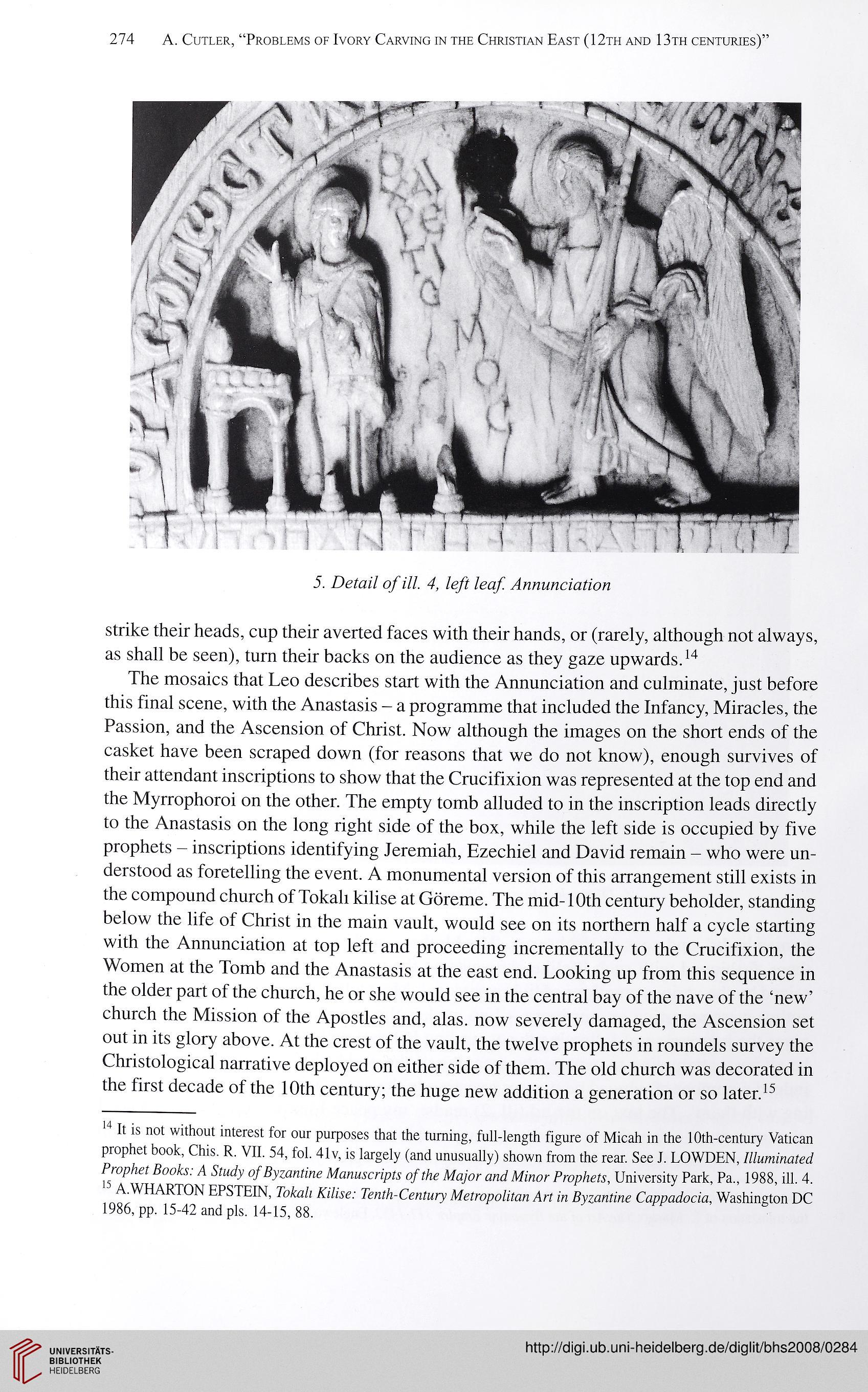274 A. CUTLER, "PROBLEMS OF IVORY CARVING IN THE CHRISTIAN EAST (12TH AND 13TH CENTURIES)'
3. DefgtV o/ t7/. 4, /g/ł /get/. Attttttttgt'etft'ott
strike their heads, cup their averted faces with their hands, or (rarely, although not always,
as shall be seen), tum their backs on the audience as they gaze upwards.^
The mosaics that Leo describes start with the Annunciation and culminate, just before
this final scene, with the Anastasis - a programme that included the Infancy, Miracles, the
Passion, and the Ascension of Christ. Now although the images on the short ends of the
casket have been scraped down (for reasons that we do not know), enough survives of
their attendant inscriptions to show that the Crucifixion was represented at the top end and
the Myrrophoroi on the other. The empty tomb alluded to in the inscription leads directly
to the Anastasis on the long right side of the box, while the left side is occupied by five
prophets - inscriptions identifying Jeremiah, Ezechiel and David remain - who were un-
derstood as foretelling the event. A monumental version of this arrangement still exists in
the compound church of Tokah kilise at Göreme. The mid-10th century beholder, standing
below the life of Christ in the main vault, would see on its northern half a cycle starting
with the Annunciation at top left and proceeding incrementally to the Crucifixion, the
Women at the Tomb and the Anastasis at the east end. Looking up from this sequence in
the older part of the church, he or she would see in the central bay of the nave of the 'new'
church the Mission of the Apostles and, alas, now severely damaged, the Ascension set
out in its glory above. At the crest of the vault, the twelve prophets in roundels survey the
Christological narrative deployed on either side of them. The old church was decorated in
the first decade of the 10th century; the huge new addition a generation or so later.
It is not without interest for our purposes that the turning, fuii-iength figure of Micah in the iOth-century Vatican
prophet book, Chis. R. VU. 54, foi. 41v, is largeiy (and unusuaiiy) shown from the rear. See J. LOWDEN, /i/ununnteJ
Brop/tet BooL; A Btut/y q/Byzantine Montrsertpt.s' q/tite Major ant/ Minor f rop/zet.s, University Park, Pa., 1988, iii. 4.
^ A.WHARTON EPSTEIN, 7Ma/t A2/i.so.' 7t^nt/i-Century Metropo/itan Art in Byzantine Cappat/oeia. Washington DC
1986, pp. 15-42 and pis. 14-15, 88.
3. DefgtV o/ t7/. 4, /g/ł /get/. Attttttttgt'etft'ott
strike their heads, cup their averted faces with their hands, or (rarely, although not always,
as shall be seen), tum their backs on the audience as they gaze upwards.^
The mosaics that Leo describes start with the Annunciation and culminate, just before
this final scene, with the Anastasis - a programme that included the Infancy, Miracles, the
Passion, and the Ascension of Christ. Now although the images on the short ends of the
casket have been scraped down (for reasons that we do not know), enough survives of
their attendant inscriptions to show that the Crucifixion was represented at the top end and
the Myrrophoroi on the other. The empty tomb alluded to in the inscription leads directly
to the Anastasis on the long right side of the box, while the left side is occupied by five
prophets - inscriptions identifying Jeremiah, Ezechiel and David remain - who were un-
derstood as foretelling the event. A monumental version of this arrangement still exists in
the compound church of Tokah kilise at Göreme. The mid-10th century beholder, standing
below the life of Christ in the main vault, would see on its northern half a cycle starting
with the Annunciation at top left and proceeding incrementally to the Crucifixion, the
Women at the Tomb and the Anastasis at the east end. Looking up from this sequence in
the older part of the church, he or she would see in the central bay of the nave of the 'new'
church the Mission of the Apostles and, alas, now severely damaged, the Ascension set
out in its glory above. At the crest of the vault, the twelve prophets in roundels survey the
Christological narrative deployed on either side of them. The old church was decorated in
the first decade of the 10th century; the huge new addition a generation or so later.
It is not without interest for our purposes that the turning, fuii-iength figure of Micah in the iOth-century Vatican
prophet book, Chis. R. VU. 54, foi. 41v, is largeiy (and unusuaiiy) shown from the rear. See J. LOWDEN, /i/ununnteJ
Brop/tet BooL; A Btut/y q/Byzantine Montrsertpt.s' q/tite Major ant/ Minor f rop/zet.s, University Park, Pa., 1988, iii. 4.
^ A.WHARTON EPSTEIN, 7Ma/t A2/i.so.' 7t^nt/i-Century Metropo/itan Art in Byzantine Cappat/oeia. Washington DC
1986, pp. 15-42 and pis. 14-15, 88.




